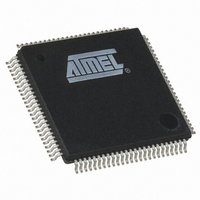AT91SAM7A3-AU Atmel, AT91SAM7A3-AU Datasheet - Page 156

AT91SAM7A3-AU
Manufacturer Part Number
AT91SAM7A3-AU
Description
IC ARM7 MCU FLASH 256K 100LQFP
Manufacturer
Atmel
Series
AT91SAMr
Specifications of AT91SAM7A3-AU
Core Processor
ARM7
Core Size
16/32-Bit
Speed
60MHz
Connectivity
CAN, I²C, MMC, SPI, SSC, UART/USART
Peripherals
POR, PWM, WDT
Number Of I /o
62
Program Memory Size
256KB (256K x 8)
Program Memory Type
FLASH
Ram Size
32K x 8
Voltage - Supply (vcc/vdd)
1.65 V ~ 1.95 V
Data Converters
A/D 8x10b
Oscillator Type
Internal
Operating Temperature
-40°C ~ 85°C
Package / Case
100-LQFP
Controller Family/series
AT91SAM7xx
No. Of I/o's
62
Ram Memory Size
32KB
Cpu Speed
60MHz
No. Of Timers
3
Rohs Compliant
Yes
Package
100LQFP
Device Core
ARM7TDMI
Family Name
91S
Maximum Speed
60 MHz
Operating Supply Voltage
3.3 V
Data Bus Width
32 Bit
Number Of Programmable I/os
62
Interface Type
CAN/SPI/I2S/TWI/USART/USB
On-chip Adc
2(8-chx10-bit)
Number Of Timers
3
Processor Series
AT91SAMx
Core
ARM7TDMI
Data Ram Size
32 KB
Maximum Clock Frequency
60 MHz
Maximum Operating Temperature
+ 85 C
Mounting Style
SMD/SMT
3rd Party Development Tools
JTRACE-ARM-2M, MDK-ARM, RL-ARM, ULINK2
Development Tools By Supplier
AT91SAM-ICE, AT91-ISP, AT91SAM7A3-EK
Minimum Operating Temperature
- 40 C
Cpu Family
91S
Device Core Size
32b
Frequency (max)
60MHz
Total Internal Ram Size
32KB
# I/os (max)
62
Number Of Timers - General Purpose
3
Operating Supply Voltage (typ)
3.3V
Operating Supply Voltage (max)
3.6V
Operating Supply Voltage (min)
3V
Instruction Set Architecture
RISC
Operating Temp Range
-40C to 85C
Operating Temperature Classification
Industrial
Mounting
Surface Mount
Pin Count
100
Package Type
LQFP
For Use With
AT91SAM-ICE - EMULATOR FOR AT91 ARM7/ARM9AT91SAM7A3-EK - KIT EVAL FOR AT91SAM7A3
Lead Free Status / RoHS Status
Lead free / RoHS Compliant
Eeprom Size
-
Lead Free Status / Rohs Status
Details
Available stocks
Company
Part Number
Manufacturer
Quantity
Price
Company:
Part Number:
AT91SAM7A3-AU
Manufacturer:
MXIC
Quantity:
1 001
Company:
Part Number:
AT91SAM7A3-AU
Manufacturer:
Atmel
Quantity:
730
- Current page: 156 of 594
- Download datasheet (7Mb)
24.3
24.4
24.5
156
Processor Clock Controller
USB Clock Controller
Peripheral Clock Controller
AT91SAM7A3 Preliminary
The PMC features a Processor Clock Controller (PCK) that implements the Processor Idle
Mode. The Processor Clock can be enabled and disabled by writing the System Clock Enable
(PMC_SCER) and System Clock Disable Registers (PMC_SCDR). The status of this clock (at
least for debug purpose) can be read in the System Clock Status Register (PMC_SCSR).
The Processor Clock PCK is enabled after a reset and is automatically re-enabled by any
enabled interrupt. The Processor Idle Mode is achieved by disabling the Processor Clock, which
is automatically re-enabled by any enabled fast or normal interrupt, or by the reset of the
product.
When the Processor Clock is disabled, the current instruction is finished before the clock is
stopped, but this does not prevent data transfers from other masters of the system bus.
The USB Source Clock is the PLL output. If using the USB, the user must program the PLL to
generate a 48 MHz, a 96 MHz or a 192 MHz signal with an accuracy of ± 0.25% depending on
the USBDIV bit in CKGR_PLLR.
When the PLL output is stable, i.e., the LOCK bit is set:
Figure 24-2. USB Clock Controller
The Power Management Controller controls the clocks of each embedded peripheral by the way
of the Peripheral Clock Controller. The user can individually enable and disable the Master
Clock on the peripherals by writing into the Peripheral Clock Enable (PMC_PCER) and Periph-
eral Clock Disable (PMC_PCDR) registers. The status of the peripheral clock activity can be
read in the Peripheral Clock Status Register (PMC_PCSR).
When a peripheral clock is disabled, the clock is immediately stopped. The peripheral clocks are
automatically disabled after a reset.
In order to stop a peripheral, it is recommended that the system software wait until the peripheral
has executed its last programmed operation before disabling the clock. This is to avoid data cor-
ruption or erroneous behavior of the system.
• The USB device clock can be enabled by setting the UDP bit in PMC_SCER. To save power
on this peripheral when it is not used, the user can set the UDP bit in PMC_SCDR. The UDP
bit in PMC_SCSR gives the activity of this clock. The USB device port require both the 48
MHz signal and the Master Clock. The Master Clock may be controlled via the Peripheral
Clock Controller.
Source
Clock
USB
USBDIV
Divider
/1,/2,/4
UDP
UDP Clock (UDPCK)
6042E–ATARM–14-Dec-06
Related parts for AT91SAM7A3-AU
Image
Part Number
Description
Manufacturer
Datasheet
Request
R

Part Number:
Description:
MCU ARM9 64K SRAM 144-LFBGA
Manufacturer:
Atmel
Datasheet:

Part Number:
Description:
IC ARM9 MPU 217-LFBGA
Manufacturer:
Atmel
Datasheet:

Part Number:
Description:
MCU ARM9 ULTRA LOW PWR 217-LFBGA
Manufacturer:
Atmel
Datasheet:

Part Number:
Description:
MCU ARM9 324-TFBGA
Manufacturer:
Atmel
Datasheet:

Part Number:
Description:
IC MCU ARM9 SAMPLING 217CBGA
Manufacturer:
Atmel
Datasheet:

Part Number:
Description:
IC ARM9 MCU 217-LFBGA
Manufacturer:
Atmel
Datasheet:

Part Number:
Description:
IC ARM9 MCU 208-PQFP
Manufacturer:
Atmel
Datasheet:

Part Number:
Description:
MCU ARM 512K HS FLASH 100-LQFP
Manufacturer:
Atmel
Datasheet:

Part Number:
Description:
MCU ARM 512K HS FLASH 100-TFBGA
Manufacturer:
Atmel
Datasheet:

Part Number:
Description:
IC ARM9 MCU 200 MHZ 324-TFBGA
Manufacturer:
Atmel
Datasheet:

Part Number:
Description:
IC ARM MCU 16BIT 128K 256BGA
Manufacturer:
Atmel
Datasheet:

Part Number:
Description:
IC ARM7 MCU 32BIT 128K 64LQFP
Manufacturer:
Atmel
Datasheet:

Part Number:
Description:
IC ARM7 MCU FLASH 256K 128-LQFP
Manufacturer:
Atmel
Datasheet:

Part Number:
Description:
IC ARM7 MCU FLASH 512K 128-LQFP
Manufacturer:
Atmel
Datasheet:

Part Number:
Description:
IC ARM9 MPU 217-LFBGA
Manufacturer:
Atmel
Datasheet:











